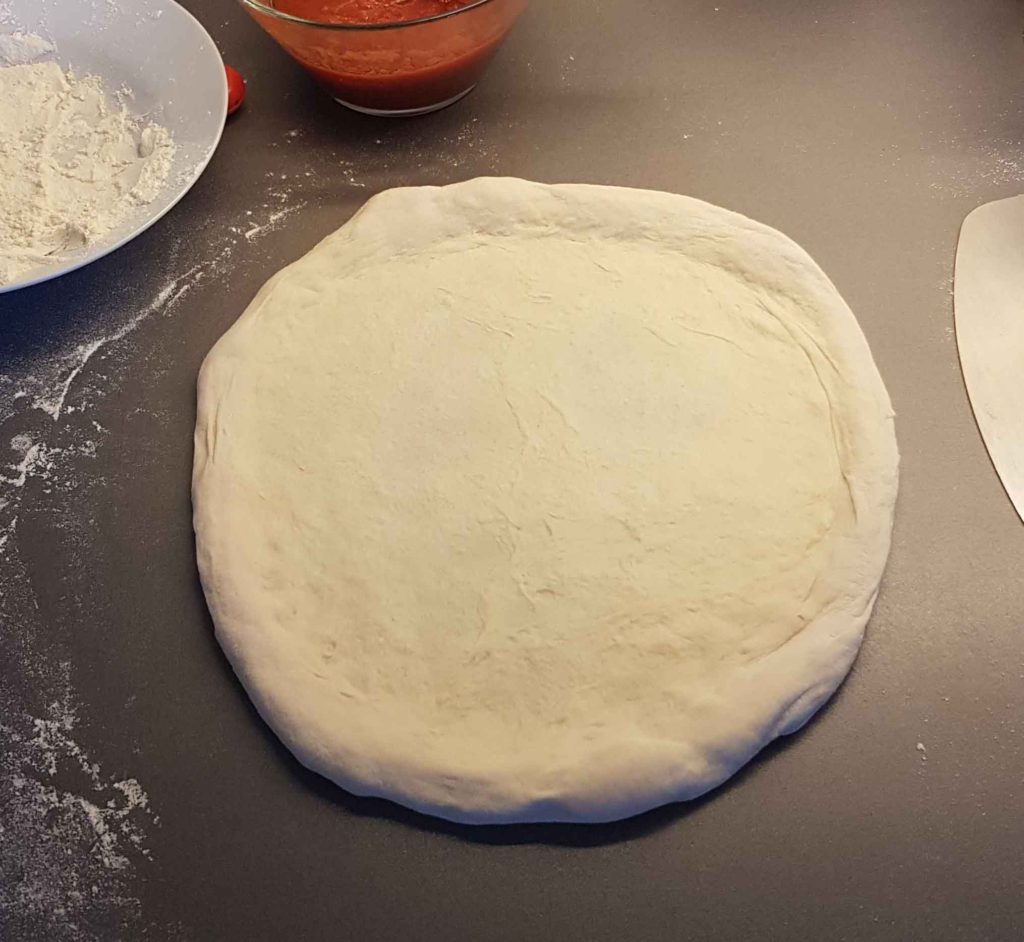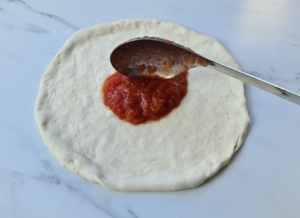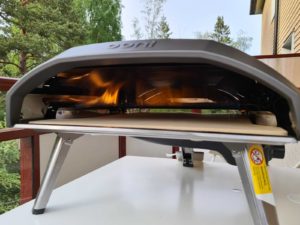Are you struggling with a flat, and dense pizza crust? And are you wondering how to achieve a tall, puffy pizza crust with air bubbles? Then you’ve come to the right place. This article will explain everything you need to know to make the perfect airy, bubbly pizza crust!
The most important things to get a bubbly, open, and airy pizza crust are:
- Proper gluten development
- A long, slow fermentation
- A relaxed dough
- Oven spring when baking the pizza
Let’s have a look at the different factors and how you can improve your dough.
What is pizza oven spring?
Oven spring is the combination of the last burst of rising from the yeast, and water in the dough turning into steam inflating the dough when the pizza is exposed to the heat of the oven. The result is a taller crust with an open crumb and large air bubbles.
When yeast is exposed to heat it speeds up the fermentation process. So when you launch your pizza inside a piping hot oven, the yeast gives a last burst of rising before it dies from the heat. Air pockets in the dough will be filled with CO2, expanding and increasing the volume until the yeast reaches around 120°F (50°C), and dies from the heat.
At the same time, the heat also turns the water in the dough into steam. And the steam inflates the air pockets in the dough even more. So the CO2 and steam inflate the air pockets in the dough like a balloon.
Eventually, moisture from the dough evaporates and the crust starts drying out and turning crispy, solidifying the crust and its air bubbles. And you’re left with a tall. light crust.
What causes oven spring and air bubbles in the pizza crust?
Oven spring and air bubbles are a result of small air pockets created by gluten and kneading being inflated with air CO2 from the yeast and steam from water during baking.
When you hydrate the flour and knead pizza dough you create a gluten network. This network grows tighter and stronger the longer you work the dough. When you knead, you also incorporate air into the dough, creating small air pockets.
During fermentation, the yeast breaks down carbohydrates in the flour and eats them. A side effect of this process is CO2, which will be trapped in the pocket inside the dough. These will slowly fill up with gas as the yeast works its way through the carbohydrates. And this is what causes the dough to rise, the gas slowly filling all the small pockets inside the dough.
If you stretch and shep the pizza the right way (more on this later), these pockets will be preserved in the rim (cornicione) of the pizza. When you bake your pizza at a high temperature, water in the dough will turn into steam, expand the air pockets, and create a tall, light rim with air bubbles. The higher the temperature, the more the crust will puff up. Which is one of the reasons you bake pizza at such a hot temperature.
So the key to making a bubbly pizza crust is proper gluten development, fermentation, relaxation, and baking the pizza fast at a high temperature.
How to increase oven spring and make bubbly pizza crust
Two things affect how light, airy, and bubbly your pizza crust gets – the type of dough and the baking method.
Dough for bubbly pizza crust
To make a dough that develops a bubbly crust, you need the right amount of gluten and gluten development. This will create pockets that can turn into bubbles without popping. The second thing is to let the gluten relax enough. This makes the gluten network in your dough more extensible and allows larger air bubbles to form during baking.
Hydration, the amount of water compared to flour in your dough, also affects the oven spring and the size of the bubbles. The higher the hydration, the more extensible it will get, and the larger the bubbles will form.
Baking to make bubbly pizza crust
The second part is baking. And the most important thing when it comes to baking the pizza is the temperature. Higher temperatures make the oven spring happen faster, which will result in a larger taller curst with a more open crumb.
You will get the best oven spring in a proper
Unfortunately, most of us don’t have a wood-fired oven in the backyard, but you can get the same result with an
If you bake pizza in a regular home oven, you’ll get the best result by using the highest temperature in the oven. An even better oven spring uses a pizza stone or
How to make dough for bubbly pizza and an open crumb
To make the perfect bubbly pizza with an open crumb, you need to:
- Use flour with a gluten content of 11-13%
- Use hydration of 65-75%
- Sufficient kneading to develop the gluten structure
- A long, slow fermentation
- Let the pizza dough relax before baking
- Stretch and shape the pizza to preserve the air pockets in the rim to maximize oven spring
Flour for bubbly pizza crust
You need flour with the right amount of gluten to make a bubbly pizza crust. This is important to get the gluten network that can hold on to the air without the bubbles popping, but not too strong to prevent inflation and expansion of the dough to form air bubbles.
Flour for a bubbly pizza crust should have a gluten content of around 11-13%.
My favorite pizza flour is Caputo Pizzeria. Caputo Pizzeria is a high-quality Tipo 00 flour with a gluten content of 12.5% and a strength of W260-270 and is one of the most used flour by pizza makers in Naples. It’s great for long, slow fermentation, and it’s designed to not burn at high temperatures, making it the perfect flour for Neapolitan pizza baking in my opinion.
If you can’t find Caputo Pizzeria or a similar pizza flour, you can also use bread flour. Bread flour usually has a slightly higher gluten content, but it’s still a great choice for pizza baking.
Hydration for a bubbly pizza crust
The ideal hydration for a bubbly pizza crust is 65-75%. The optimal hydration depends on the flour you use, but higher hydration makes the dough more extensible, allowing larger air bubbles to form.
But what does 65-75% hydration mean?
Hydration is simply the amount of water in your dough. In baking, this is usually expressed as baker’s percentages. Baker’s percentages simply mean that you measure an ingredient in your dough in relation to the amount of flour, which is convenient for scaling a dough formula. For example:
If your dough contains 1000g of flour and 600g of water, it has a hydration of 60%. If it contains 700g of water, it has a hydration of 70%.
You can read more about hydration and baker’s percentages here.
Kneading the dough
To get sufficient gluten development, you should knead your pizza dough for 10-15 minutes by hand or for 15-20 at medium speed in a stand mixer.
Kneading serves two purposes:
- Develop the gluten network
- Incorporate air into the dough to make air bubbles.
When you knead your pizza dough, the gluten in the flour will start to develop a network inside your dough. This network looks almost like a fishing net and grows stronger and tighter, the longer you knead your dough. When these nets grow strong and tight enough they will create small pockets inside your dough when you knead and fold the dough. These pockets are what grow into bubbles when they’re slowly filled with CO2 from the yeast during the fermentation process.
If you don’t knead your dough enough, the gluten network will not be strong enough to keep the structure of the dough and hold onto the CO2. The dough will collapse, and create a dense crust.
But kneading too much is not good either. If you knead the dough for too long, the gluten network will get so tight and strong that the air pockets will not inflate and grow into large bubbles.
Fermentation
Fermentation is an important step in the pizza-making process. Perhaps the most important step. During fermentation, the yeast in the dough breaks down complex carbohydrates in the flour. These carbohydrates serve as food for the yeast, and when it works its way through the dough, the yeast turns carbohydrates into CO2 and alcohol. A byproduct of the process is flavor and a more digestible pizza crust.
If the dough has proper gluten development, the CO2 from the fermentation process will be trapped. And the dough will slowly rise, as it fills the air pockets with CO2. This is the starting point for a light and open crumb.
How long you should let your dough ferment depends on the amount of yeast and the temperature you let the dough rise at. But to get a flavorful, bubbly pizza crust, you should aim for a fermentation time of 8-24 hours.
Read more bout fermentation here.
Let the dough relax
To get large bubbles and an open crust, the gluten needs to be relaxed before you bake your pizza. This allows for a proper oven spring.
Then the dough is left to relax, the gluten network will get more extensible. A more extensible gluten network allows larger air bubbles to form. If you reshape your dough or make dough balls, the gluten network will tighten. So you need to let the dough relax for at least 4 hours before stretching and baking your pizza.
Stretching and shaping the pizza
Stretching the dough the right way is essential to get oven spring and air bubbles.
If you want a bubbly crust, never use a rolling pin! Using a rolling pin will press all the air out from the dough and create a flat, dense crust.
To stretch pizza dough, start by carefully moving the dough from your rising box or bowl to a floured working surface. You want to cover it in flour to prevent it from sticking. Then, press the middle of the dough flat using the palm of your hand, and carefully work your way out towards the edge of the pizza. But leave around 1/2 inch (1 cm) of the edge untouched. This is what will puff up and create the rim of your pizza. Then carefully stretch the pizza larger, until you reach the desired size. But be careful to not puncture your rim!

Next, top your pizza with sauce, cheese, and your favorite toppings, and get it ready for the oven.
The easiest way to make bubbly pizza crust is using poolish
One of the easiest ways to achieve bubbly pizza crust is to use a starter to make your dough. A starter or a pre-ferment is a mix of flour water and yeast, that you leave to ferment before adding it during the mixing of the main dough. The benefit of using a starter is that it gives the gluten time to develop. And the result is an extensible dough with more oven spring.
The extra fermentation times also improve the flavor of the dough!
The easiest starter is poolish. Watch is a mix of equal parts flour and water, plus a small pinch of yeast. Then leave it to ferment for 2-24 hours before adding it as part of the main dough.
Click here to see the full recipe for poolish pizza: Neapolitan pizza dough with poolish.
How to bake pizza to maximize bubbles and spring
The most important thing to get a good oven spring is a high baking temperature and fast baking.
Baking pizza
You will get the best oven spring and pizza in a
Launch the pizza into the oven using a

Baking at home
If you don’t have access to a
How to prevent burned bubbles in your pizza crust
In a gas or wood-fired
You may want air bubbles in your crust, but you don’t want huge black balloons. They will not taste good, nor look appetizing.
So to prevent this from happening, you should pop any visual bubbles during stretching and shaping your pizza. This might sound counter-intuitive since you want bubbles. But these will just cause problems. They will grow too large too fast and burn in the oven.
You also have to keep a close eye on the pizza during baking. In a 7-800 degree oven, bubbles, and the rest of the crust, can go from done to burnt in seconds. So you should constantly rotate the pizza using a turning peel to make sure you’ll get an even bake.
Frequently asked questions about bubbly pizza crust (FAQ)
What makes a pizza crust bubbly?
Bubbles in the pizza crust are the result of proper gluten development, a long slow fermentation, and oven spring created by a fast and hot bake.
Small air pockets form in the dough during kneading. These air pockets are filled with CO2 from the yeast during fermentation. When you bake the pizza at a high temperature the yeast speeds up before the heat kills it, inflating the air pockets during the final burst of fermentation. As the temperature rises, water in the dough turns into steam, and inflates the air pockets even more, creating large bubbles, and an open crust.
How can you make your pizza dough airier?
To make an airier crust, you should increase the hydration of the dough, and make sure the gluten is relaxed before baking. The relaxed gluten will make it more extensible and allow larger bubbles to form, and higher hydration will make more steam inflate the dough during baking.
It’s also important to handle the rim carefully during stretching and shaping the pizza to prevent pressing the air out from the crust.
What is the best flour for a bubbly pizza crust?
The most important is the gluten content and strength of the flour. The flour should have a gluten content of 11-13%.
In my opinion, the best pizza flour for a bubbly pizza crust is Caputo Pizzeria because it has the right gluten content, can withstand a long fermentation time, and doesn’t burn in a hot
How long should dough balls relax before baking to create a bubbly pizza crust?
Before stretching and baking, the pizza dough balls should rest for at least 4 hours, ideally 8. When the gluten is relaxed the air bubbles will grow larger during baking.
Should your pizza crust have bubbles?
Bubbles formation is a natural result of relaxed gluten and baking at a high temperature. And it will make the crust feel lighter and airier. However large bubbles can cause problems when baking pizza in a hot
Related
- Is Your Pizza Dough Too Dry? Here is How to fix it! - June 10, 2024
- The Ultimate Guide to the Pizza Dough Windowpane Test - June 8, 2024
- The Ultimate Guide to Autolyse Pizza Dough - June 7, 2024





